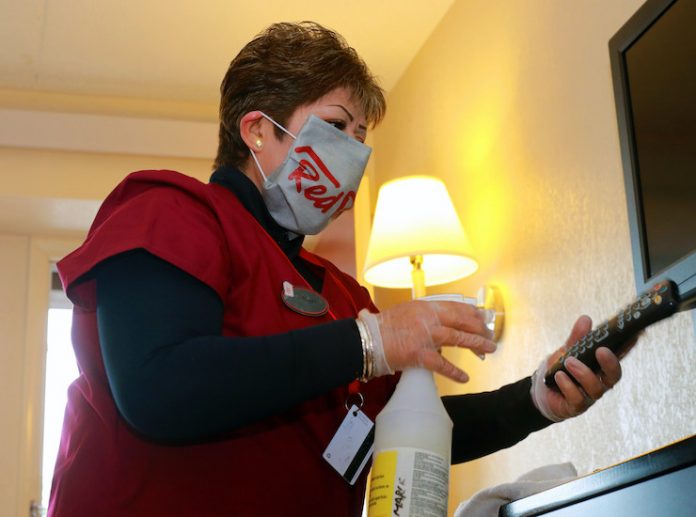In the earliest days of the pandemic, Red Roof didn’t need to be told that changes would have to be made. The company quickly put together a task force with representatives from across its departments to face the gathering storm. From there, Red Roof launched RediClean, enhanced cleaning protocols and training to combat the spread of COVID-19 and give travelers confidence to return to its hotels. Red Roof also joined the American Hotel & Lodging Association’s Safe Stay Advisory Council to weigh in on what an industry-wide enhanced standard of health and safety protocols would look like. Because of these early actions, Red Roof achieved 100 percent brand commitment to adhere to the RediClean protocols, which are in alignment with AHLA’s Safe Stay training released earlier this month.
Executive Vice President of Operations Robert Hubbard and Director of Training Steve Woodward shared with LODGING the measures Red Roof has taken to keep its protocols updated and ensure employees know how to implement them—all to help employees, guests, and partners feel confident in a safe and healthy stay at Red Roof hotels.
When and why did Red Roof start developing RediClean and what was the rollout process like over the first couple of months?
Hubbard: We first heard about the virus in the Seattle market back in January and joined the conversation going on in the industry. We didn’t know then where it was heading, but we convened our own COVID task force to develop a protocol to address it within our company. As a result, we were able to roll out a cleaning standard enhancement called RediClean in early March at all properties. Then, when AHLA introduced its SafeStay program, we tweaked our program accordingly.
How are content and training for the RediClean program being handled?
Woodward: We were really aggressive on this issue. Our enhanced cleaning protocol program, RediClean, was already out there, so when the CDC issued its recommendations and AHLA came out with Safe Stay, we were able to easily make the necessary enhancements. Our staff had already participated in a required RediClean training—a blend of webinar and on-demand training—which we tracked in our learning management system to make sure everyone was comfortable with it. Once we did that, we continued updating the training with new material. To make sure it was getting out there—even if there were technology or language barriers—we had it translated into multiple languages and sent hard copies out to all properties.
Starting with the program in which our staff was already trained, we added things like the linen protocol, requiring that towels and bedding be bagged, and suspended cleaning stay-over rooms every day. Then, when amenities like pools and fitness centers began reopening, we adopted and trained in those protocols as well.
Ongoing, there is a weekly email that serves as a vehicle for communication; in addition, as changes continue coming in, properties receive an email directly from our president, Andrew Alexander.
What resources are available to franchised properties to support them in implementing new guidelines and otherwise welcoming guests back safely?
Hubbard: Beyond the training and communication mentioned, our procurement department was crucial in that it made sure properties could get the correct products based on CDC guidelines—many of which were in short supply—so they could implement the program.
Also, because our marketing and sales group was part of the COVID task force, they were able to effectively support the message that our priority was ensuring the safety of everyone—especially guests—to make sure they feel comfortable and secure about travel.
Why is it important to have an industry-wide program like AHLA’s Safe Stay?
Hubbard: We created our RediClean program to make sure we’re guest-ready, and we’re happy to continue to improve it—and with it, guests’ confidence—as more information and best practices become available. Working hand in hand with AHLA and promoting and adopting its updated guidelines is key in supporting consumer confidence—not just in our properties, but across our industry overall.
This situation remains fluid, but establishing that confidence that we can offer a safe place to stay enables us to also reach out to markets that aren’t traveling. Our efforts to meet the needs of first responders and other essential workers continue, but we are also exploring other markets, like college students who either can’t return to their own countries or need to find alternatives to dorms in light of social distancing requirements. Then there are the people tired of working from home and its many distractions who could take advantage of day rates in a hotel room with free WiFi.
Woodward: Consistency across the brand is not only the key to winning over consumers but it also instills confidence in developers. We’ve actually been opening up new properties. We find it amazing and exciting that we’re building genuine relationships within the franchise community, setting them up for success.
What have you learned over these months while adapting to the crisis that will inform the moves you make in the months ahead?
Hubbard: One of the main things is adaptability, being more fluid than before, and understanding that consumers will be the ones driving expectations, not only in terms of cleanliness—which we’ve got a handle on—but in other ways, such as using technology to reduce contact and otherwise make them feel safer. Although we have always monitored social media and sought to respond to consumer feedback, recent events have enlightened us about the importance of being even more on top of it.
Some of what we’ll be pondering will be how amenities—such as breakfast, gyms, and pools—will look going forward. We want to welcome back Americans who love to travel. As people start to feel more comfortable, we want to reassure them as an organization and as a brand.











